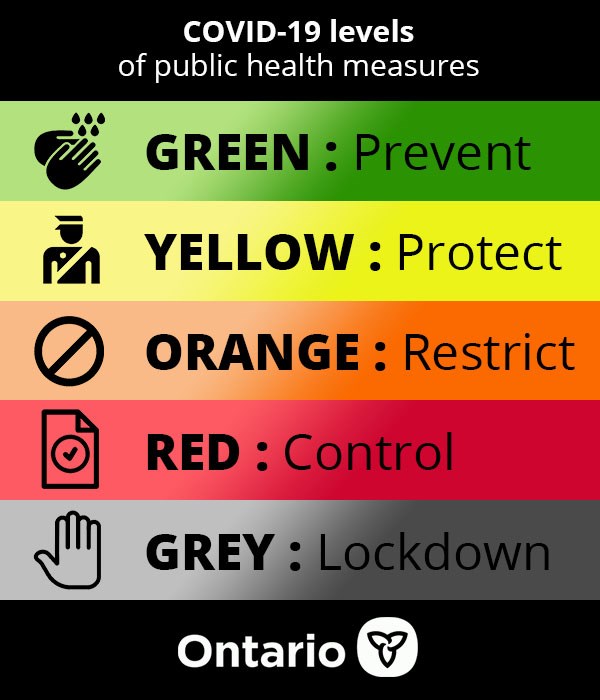After announcing a phased-in approach to reopening Ontario earlier this week, the province has provided more details.
Twenty-seven health unit regions will be transitioning out of the shutdown into a revised COVID-19 Response Framework.
Four high-risk regions — Peel, Toronto, York and North Bay Parry Sound District — where the case numbers have been the highest, will keep the shutdown and stay-at-home measures until at least Feb. 22.
The levels for the regions that start Feb. 16 at 12:01 a.m. are:
Grey-Lockdown
- Niagara Region Public Health
Red-Control
- Chatham-Kent Public Health;
- City of Hamilton Public Health Services;
- Durham Region Health Department;
- Halton Region Public Health;
- Middlesex-London Health Unit;
- Region of Waterloo Public Health and Emergency Services;
- Simcoe-Muskoka District Health Unit;
- Southwestern Public Health;
- Thunder Bay District Health Unit;
- Wellington-Dufferin Guelph Public Health; and
- Windsor-Essex County Health Unit.
Orange-Restrict
- Brant County Health Unit;
- Eastern Ontario Health Unit;
- Haldimand-Norfolk Health Unit;
- Haliburton, Kawartha, Pine Ridge District Health Unit;
- Huron Perth Public Health;
- Lambton Public Health;
- Ottawa Public Health;
- Porcupine Health Unit; and
- Public Health Sudbury and Districts.
Yellow-Protect
- Algoma Public Health;
- Grey Bruce Health Unit;
- Northwestern Health Unit; and
- · Peterborough Public Health.
Green-Prevent
- Leeds, Grenville and Lanark District Health Unit; and
- Timiskaming Health Unit.
Three regions — Hastings and Prince Edward Counties Health Unit, Kingston, Frontenac and Lennox Addington Health Unit, and Renfrew County and District Health Unit — moved into the green zone of the COVID-19 Regional Response Framework Feb. 10.
Regions returning to the framework will stay at the level for at least two weeks. At that point, the government will assess the impact of public health and workplace safety measures to determine if the level should change.
Visitor restrictions for long-term care homes apply once the region is in Orange or higher.
Ontario's second state of emergency ended Feb. 9.
Orders in place under the Emergency Management and Civil Protection Act (EMCPA) have been extended to Feb. 23. A full list of emergency orders under the EMPCA are available on the e-Laws website and at Ontario.ca/alert.
The number of daily cases in Ontario has been declining recently, although Ontario's top doctors issued a warning about the potential impact of the variants of concern this week.
Three variants have been identified in the province — the United Kingdom (B.1.1.7) strain, the South African (B.1.251), and Brazilian.
A presentation yesterday said the UK variant (B.1.1.7) is spreading and that case numbers will likely grow again in late February, with ICU admissions increasing after.
It noted that aggressive vaccination and sticking with the stay-at-home order would help avoid a third wave and third lockdown.
A province-wide shutdown took effect Dec. 26. On Jan. 12, Ford declared the second state of emergency in Ontario since the start of the pandemic. The stay-at-home order went into effect Jan. 14.
The first state of emergency in the province was declared March 17 and remained in effect until July 24.
